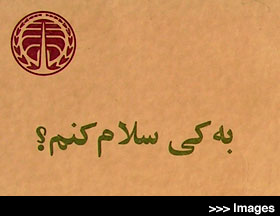 Don't cry for me, Oriana Don't cry for me, Oriana
Part 4: Returning to Iran: 1986-87
>>> Images
Sima Nahan
March 24, 2006
iranian.com
Iranian women -- those who "even here have demonstrated that they are equal to men" -- are not allowed a categorical denial of the veil. They have been forced to learn to swallow their modern rage against the "medieval rag" by perceiving it as the social/political phenomenon that it is, and trivializing the thing in itself. In fact, one could say that the most pervasive and systematic act of everyday rebellion against the Islamic Republic has been the untiring experimentation of Iranian women with maintaining feminine dignity and, indeed, beauty in the face of the humiliations of the hejab.
The veil, or, more accurately, the uniform of the Islamic Republic -- the rupush and rusari, the long and loose overgarment and head scarf that women have the option to wear instead of the chador -- has become an ever new vehicle for expressing pride and dissent, paired with the most frivolous statements of fashion. In keeping up with the times, shoulder pads appear underneath the rupush; perms become popular for combating the limpness that results from covering hair with clinging scarves day in and day out; lace gloves make a comeback, begrudgingly covering painted and manicured fingernails.
One particularly elegant woman with an acute postmodern sensibility has a series of overgarments made for her with the cut of the 'aba (the mantle of the mullahs) which she wears over matching "Kurdish" pants. Shunning the astronomically priced ready-to-wear European imports that are marketed around the new Meydan-e Mohseni (where many a wife of a mullah is spotted shopping), she has her patent leather na'layn (backless slippers, also part of the mullah attire) custom-made for her at the old shoemakers' row on Bagh-e Sepahsalar street.
Quite significantly, those Iranian women who did not grow up wearing the veil have developed the same keen kinesthetic sense that their veiled sisters master early on. This is the sense that allows a woman a good degree of control over the "accidental" slipping of her rusari, for instance: a stray lock of hair can make its strategic appearance and disappearance; the bare neck can most unintentionally emerge from under its coverings to happen to catch the light (and hopefully a breeze); the glint of a gold earring can flash in and out of sight for the split second it takes to attract captive attention.
A dancer I know had found a welcome sense of freedom released from the constraints of structured western clothing. She moved about in her loosest, longest rupush, gloating in the new facility with which she had learned to "project" from underneath the protective liberty of softly falling fabric. (Her friends' snide remark was that she got the idea from Peter O'Toole in Lawrence of Arabia.)
But there is little to be done about the knot of the rusari that presses like the tip of a dull knife at the throat. This serves as a constant reminder of the price that is paid daily for the vengeance with which women fight the demonization of the female body. I talked with a sixteen-year-old who was picked up on the street on account of badhejabi -- being "ill-veiled," i.e. below or in aesthetic violation of official standards. She was given the option of 30 lashes or a 30,000 toman fine. (Over the years, as the economy has worsened, cash fines are offered as an option to avoid flogging.) She had chosen the lashes. After having been detained for a whole day she and her fellow detainees of the day were given permission to call home. She had refused the call because, as she said, if her parents had learned of her situation they would have scraped up the money and rushed to bail her out.
"But I had sooner let them worry a bit longer and then go home without having made a cash contribution to the Islamic Republic," she told me. "Besides, you can't expect others to pay a price for the choices that you make."
After having shed her chador in her interview, Fallaci continued with the topic of cultural/religious differences and Khomeini summarized his perspec–tive on East/West relations:
"We are not afraid of your science and your technology. We are afraid of your ideas and your customs."
 It is on the crucial plane of ideas and customs, both attesting to the intimidating significance of foreign conventions, that the interview falls short in its effort to illuminate. It is, however, possible, in this very interview, to forgo intimations of sensationalism and explosive declarations of difference to take note of subtle leads into the darker corners of the Islamic world. It is on the crucial plane of ideas and customs, both attesting to the intimidating significance of foreign conventions, that the interview falls short in its effort to illuminate. It is, however, possible, in this very interview, to forgo intimations of sensationalism and explosive declarations of difference to take note of subtle leads into the darker corners of the Islamic world.
On the topic of Islamic polygamy, i.e. the Koranic right of Moslem men to take up to four wives, for instance, Khomeini gives the classic defense of this law: "More women are born than men, and more men are killed in war than women." Given that the superiority of the number of women born relative to men can never be or have been twofold, let alone fourfold, the validity of this assertion must rest in the reality of the number of men decreasing in war. We may see in this explanation the suggestion that just as it is the Islamic custom for a man to marry more than one wife, it is also the "custom" to expect large numbers of men to be packed off to be killed in war at regular intervals.
In Tehran it is noted that the morality brigade of the Islamic Republic, the Monkerat (the amr be ma'ruf and nahy az monkar as enforced by Revolutionary Guards and their heavily veiled female counterparts known as the Sisters of Zeynab) takes to the streets and the flogg–ing and fining of bad-hejab women just as there is a particularly bloody confrontation at the fronts. It is a practice that seems to confirm the righteousness of a ubiquitous slogan, a "message" from the Unknown Soldier/Martyr: "Sister, your hejab is more devastating to the enemy than the shedding of my blood."
It is as if the flogging of an inadequately covered woman somehow makes up for, or reinforces the effectiveness of, a man's death. A curious connec–tion nags at the mind between the subjugation of women and the shedding of men's blood. To me it suggests that if the legacy of Islamic patriarchy is the disposal of its daughters, it is also the murder of its sons.
In Tehran, on the wall of a rehabilitation center for disabled veterans (the "living martyrs") on Iranshahr Avenue, across the street from Behdari-ye Sepah (a large hospital for the Revolu–tionary Guard Corps), a most gruesome verbal expression of a certain connection is presented by a slogan attributed to none other than Martyr par-excellence, Imam Hossein: "The death of one's child is more beautiful than a necklace on the neck of a young and beautiful girl."
I copy the phrase in my notebook hoping to fathom someday the connection between female beauty and the death of young men. I am particularly baffled by the message this slogan -- appearing at this particular location -- delivers to the hundreds of thousands of the physically and psychologically mutilated veterans who seem to have deprived someone somewhere of the "beauty" of their death by remaining alive.
Yet, of course, Islam did not invent patriarchy, its myths and institutions, and the quotation above, one should hope, in the worst event of proving verifiable, must have been uttered by Hossein the Innocent under very unusual circumstances.
 To bring the matter even closer to home, one has only to think of the ancient Iranian epic, the Shahnameh, which is a long narrative of sons begotten and raised in pride only to be murdered by their fathers in rivalry. Rostam, the arch hero, avenging the blood of Siavosh for which his father, the King of Iran, is responsible, and agonizing over the trap set for Esfandiyar by his father, again the King, has the blood of his own son, Sohrab, on his hands. To bring the matter even closer to home, one has only to think of the ancient Iranian epic, the Shahnameh, which is a long narrative of sons begotten and raised in pride only to be murdered by their fathers in rivalry. Rostam, the arch hero, avenging the blood of Siavosh for which his father, the King of Iran, is responsible, and agonizing over the trap set for Esfandiyar by his father, again the King, has the blood of his own son, Sohrab, on his hands.
King and Hero are joined in this common destiny, and the mourning of Tahmineh, Farangis and Katayun, mothers and wives, runs like a subterranean river through the text of the great tragedies. Over time, with the inseparable intermingling of Iranian and Islamic rituals and tradi–tions, the tragedy of the family of Ali -- the single most enduring outlet for the expression of Shiite passion -- is drawn into this great Iranian capacity for mourning. Siyavoshun and Ta'zieh -- passion plays keeping myth and history alive in the memories of Siavosh and Hos–sein -- grieve the shedding of innocent blood >>> Images
It is this ancient grief that is bitterer to swallow than modern rage >>> Part 5
[Part (1) (2) (3) (4) (5) (6) (7) (8) (9) (10) (11) (12) (13) (14) (15) (16) (17)]
About
Sima Nahan is a writer based in California. She graduated from Reza Shah Kabir high school in Tehran.
|